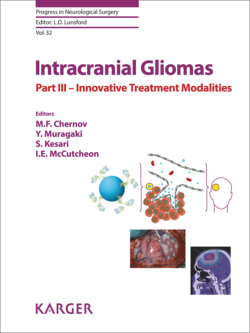Читать книгу Intracranial Gliomas Part III - Innovative Treatment Modalities - Группа авторов - Страница 37
На сайте Литреса книга снята с продажи.
NeuroBlate® System
ОглавлениеThe NeuroBlate® system for thermal therapy is based on use of a 1,064 nm diode solid state Nd:YAG laser with a 12 W pulse output (cycle of 1.6 s in “on” mode and 2.2 s in “off” mode) [13]. Percutaneous treatment is delivered via a head-mounted MRI-compatible stereotactic trajectory guidance device, either Navigus® (Medtronic, Inc.; Fridley, MN, USA) [13] or miniframe AXiiiS® (Monteris Medical, Inc.) [25–27], which is modified for securing the laser fiberoptic probe. The probe is 3.3 mm in diameter and internally cooled with CO2. The laser beam exits the probe almost perpendicularly through a sapphire tip with an exit angle of 12.5°, thus rotation of the probe over 360° and changes of its insertion depth allow precise sculpturing of the photo-irradiation to an irregular target [27]. Since recently a diffusing tip probe has also become available, but experience with its use is still limited.
Treatment is performed under general anesthesia. The patient’s head is fixed in a 3-point MRI-compatible Mayfield head holder and a cranial stereotactic trajectory device is secured to the skull. Stereotactic biopsy of the lesion may be done if needed [13, 27]. Thereafter the patient is transported to the 1.5 T iMRI suite (Siemens AG; Munich, Germany). The laser probe fiberoptic cable, cooling system, and other lines are passed through a wave guide into the control room to the NeuroBlate® control system (Fig. 1). The MRI scanner is appropriately draped and the probe driver is securely affixed to the stereotactic trajectory device allowing the surgeon to perform remote control of the probe rotation and translation. Pretreatment neuroimaging protocol includes fluid-attenuated inversion recovery (FLAIR), diffusion-weighted (DWI), T2*-, and T1-weighted volumetric images. Using the NeuroBlate® software the surgeon then manually makes tumor segmentation and identifies temperature reference points within 2 cm of the lesion margin. Probe trajectory and skull entry point are planned primarily based on post-contrast T1-weighted images. In general, treatment planning for LITT is similar to that used for stereotactic brain biopsy, while for optimization of the thermal therapy an attempt is made to select a trajectory through the center of the lesion along its longest axis. The laser probe is introduced manually to within 40 mm of the final target point and then advanced to the target by using the probe driver. Treatment is initiated by the surgeon. For tumor ablation the thermal equivalent of 43°C for 60 min is usually used [13].
The procedure is performed under guidance of real-time MR thermometry, using a fast RF-spoiled gradient-recalled echo sequence (field-of-view [FOV] 25.6 × 25.6 cm; matrix 128 × 128; echo time [TE] 19.1 msec; repetition time [TR] 81 msec; flip angle 30°; bandwidth 100 Hz/pixel; 3 slices of 5 mm thickness), which requires approximately 7.8 s for a single acquisition, thus can be viewed continuously during treatment. The NeuroBlate® software provides monitoring and visualization of the temperature changes in the tumor and adjacent brain on 3 consecutive MR images (5 mm thick with 0.25 mm gap) in a plane perpendicular to the probe and delineates thermal damage threshold (TDT) lines (Fig. 2). Color-coded demarcation of the different thermal dose volumes may allow highly precise determination of the likelihood of eventual cell death across the targeted tissue following LITT.
Treatment is stopped either manually, when it is considered that the predicted thermal ablation zone was sufficient, or automatically if any monitored limits are exceeded. Thereafter, the position of the probe may be changed and LITT may be continued to attain maximum coverage of the lesion with the prescribed thermal dose.
